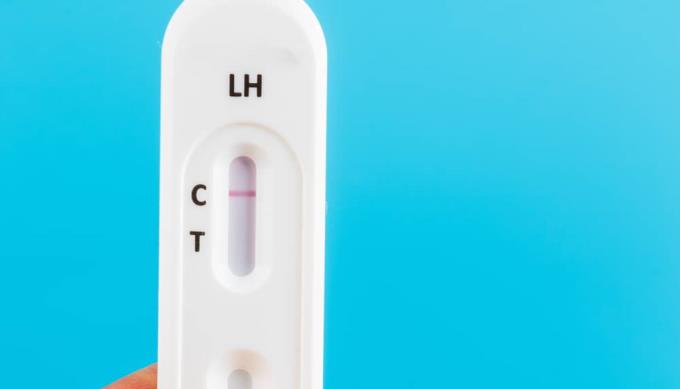Reference: Calculate your ovulation day quickly and accurately
The ovulation test is a simple yet effective tool to help you determine when you are ovulating to increase your chances of conceiving. Pregnant mothers have understood the operation of the ovulation test stick and notes when using it? With aFamilyToday Health find out the article below!
Maybe it was not a good time to give birth before, so you and your wife have used contraception . Recently, the two of you are looking forward to having a baby, but wait forever, have no good news?
One of the easy ways to get pregnant is to use an ovulation test. If you are not familiar with this tool, do not ignore the following information!
What is ovulation test?

The ovulation test is a device used to check the concentration of Luteinizing Hormone (Luteinizing Hormone) in the urine.
A small amount of the hormone LH always appears in the urine of a woman, but the concentration will increase 2-5 times before ovulation about 24 - 36 hours . This is the most fertile time in the menstrual cycle. Using a test strip can help you determine the period of time when LH hormone levels are elevated before ovulation.
The process of conception is more favorable if you have sex around the time of ovulation and are entering the oviduct, which is about 12-24 hours after ovulation. Being able to determine the date of ovulation is very helpful for couples who are waiting for the good news.
Ovulation test is correct?

According to the American Pregnancy Association , the ovulation test is up to 99% accurate in detecting high levels of the hormone LH if used correctly.
However, increasing the amount of the hormone LH is not always a sign of ovulation. Some women may experience non-ovulation even though the hormone LH is high, such as those with polycystic ovaries . If you're pregnant or menopausal, the results of the ovulation test may be affected.
In addition, certain prescription medications such as injectable menotropin (Pergonal®), danazol (Danocrine®), and drugs that contain hCG (e.g. Profasi or APL ) may affect test results. If you are treating your reproductive health problems with Clomiphene citrate medications (such as Clomid® or Serophene®), consult your doctor to make sure the ovulation test will give the correct results. .
If for some reason you are unable to use the ovulation test right after taking your urine, you can save a urine sample for later testing. However, to ensure accurate results, you should pay attention to how to store each environment:
Room temperature (15 - 28ºC): You can only store urine samples for about 8 hours.
Store in the refrigerator: for about 24 hours. You should expel the urine sample at room temperature for about 30 minutes before starting the test.
To limit the chances of getting a false result, you should have a urine test the same day.
When to use the ovulation test for accurate results?
To be able to use the ovulation test effectively, you need to determine how many days your menstrual cycle is. Keep track of your menstrual cycle for at least 3 months and make specific notes to know how many days your cycle is.
Once you have a good understanding of your menstrual cycle, use an ovulation test to monitor the urinary LH hormone index according to the instructions below:
28-day menstrual cycle: Use the test in a row for 6 days from day 11 of your cycle (from the first day of your period).
The menstrual cycle lasts from 27-34 days: Use the test continuously from day 11 to day 20 of the cycle.
Menstrual cycle shorter than 21 days or longer than 40 days: You should see your gynecologist and consult an obstetrician to be able to use the test most effectively.
You can get a better view of when to take a pregnancy test with the following table:
Long cycle (days) Test start date (from the first day of your period)
21Day 5
22Day 5
23rd day of 6
24th day 7
25th day 8
26Day 9
27th day 10
28th day 11
29Day 12
30th day 13
31Day 14
32th day 15
33 Day 16
34th day 17
35th day 18
36th day 19
37th day 20
38 Day 21
39 22nd day
40th day
Also, you should not take urine as soon as you wake up to test, as the results will not be completely accurate. According to BabyCentre , the best time of day to use the ovulation test is from about 10-22 hours, especially about 14 hours - 14 hours 30 minutes.
In addition, you should reduce your fluid intake about 4 hours before collecting urine. When you tolerate too much fluids, the urine becomes dilute, making it difficult for the test to detect an increase in levels of the hormone LH.
How to use and read ovulation test results
To use the ovulation test correctly and get the most accurate results, take note of the following points.
The use of ovulation test strips

Although there are many types of ovulation test strips (paper and electronic sticks), their usage is generally similar:
Step 1: Remove the test strip from the bag. Collect the urine in the cup provided in the test strip container.
Step 2: Dip the test strip in the urine in the direction of the down arrow. You must not submerge above the specified line.
Step 3: Wait about 3-5 seconds, take out the test stick and place it in a dry place.
Step 4: You should read the results within 5 minutes to avoid changes in the pregnancy test that could cause the results to appear wrong.
How to read the results of the ovulation test
You may experience the following results after using the ovulation test:
Rod shows 1 bar above: Not the time of ovulation.
Rod shows 1 dark line 1 fuzzy line: Ovulation time is quite far.
The stick shows 2 equal lines (2 dark lines or 2 fuzzy lines): This means you are nearing the date of ovulation.
The stick shows 2 bars (the lower line is darker than the one available on the stick): Your ovulation time is near. Eggs release within 12-24 hours immediately after.
For electronic pregnancy tests, results can be represented by icons, such as a smiley face.
Note that when the eggs are or are ovulating, if you use the test stick, the second line will still appear. But it will fade if the time you try is far away from ovulation.
Should we use ovulation test to prevent pregnancy?

Using an ovulation test to prevent pregnancy can carry many risks and cause you to have an unwanted pregnancy . The reason is that the test can only detect a spike in LH hormone levels for 24 to 48 hours before ovulation occurs, while sperm can stay in the body for 3 to 5 days. .
Therefore, if you had sex before you discovered the surge in LH, the egg can still be fertilized.
How to buy an ovulation test?
If you do not know what type of ovulation test to buy, aFamilyToday Health would suggest you can use one of the following three types of test:
Ovulation test strip LH Test Kit
Abon ovulation test strip
Acon ovulation test strip
These are the most popular brands of ovulation sticks on the market today that you can buy at any drugstore.
In terms of price, depending on the manufacturer, each type of test strip will have a different price. The price ranges from 70,000 VND to 100,000 VND / box of 10 test strips.
Hope the above information will help you use the most effective ovulation test. In addition, do not forget to learn about how to use and read the results of the pregnancy test to know you are pregnant!
Wish you good news soon!















